The main outline of the article printed below was originally posted in Payvand News “Book: The Great Famine and Genocide in Persia, 1917-1919” (10/26/12) as well as Amazon.com. The version printed below has been significantly edited with (excepting the book jacket) all photos and accompanying captions not appearing in the original Payvand News and Amazon postings.
Readers further interested in these topics are encouraged to consult the following resource:
Readers are also cautioned that the article and the accompanying images below may be disturbing to some viewers.
==================================================================================
Dr. Mohammad-Gholi MaJd –محمدقلي مجد– of Princeton University has written an excellent book entitled:
- Author: Mohammad-Gholi MaJd
- Title: The Great Famine and Genocide in Iran in 1917-1919
- Publisher: University Press of America, 2003
- ISBN-10: 0761826335
- ISBN-13: 978-0761826330
- Order at Amazon.
Dr. Majd’s book outlines the huge loss of civilian life in Iran during World War One and after as a result of British, Russian and Ottoman military, political and economic interference.
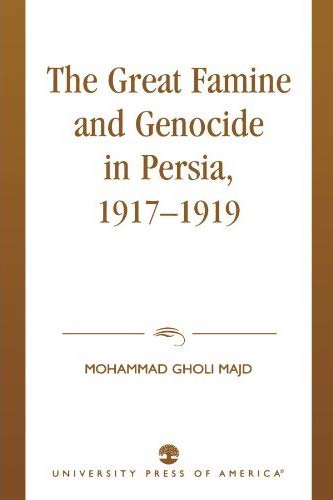
Below is a highly informative book description posted at Amazon:
At least 8–10 million Iranians out of a population of 18–20 million died of starvation and disease during the famine of 1917–1919. The Iranian holocaust was the biggest calamity of World War I and one of the worst genocides of the 20th century, yet it remained concealed for nearly a century. The 2003 edition of this book relied primarily on US diplomatic records and memoirs of British officers who served in Iran in World War I, but in this edition these documents have been supplemented with US military records, British official sources, memoirs, diaries of notable Iranians, and a wide array of Iranian newspaper reports. In addition, the demographic data has been expanded to include newly discovered US State Department documents on Iran’s pre-1914 population. This book also includes a new chapter with a detailed military and political history of Iran in World War I. A work of enduring value, Majd provides a comprehensive account of Iran’s greatest calamity.
The Allies refused to pay for local oil, greatly aggravating the conditions brought on by the drought and famine. Between 1917 and 1919, it is estimated that nearly one-half (9-11 million people) of the Persian population died of starvation or disease brought on by malnutrition. Those men fit enough to fight, took up active resistance against the British, who now controlled most of the region. This is all more or less verifiable history, although little of these events are known today.
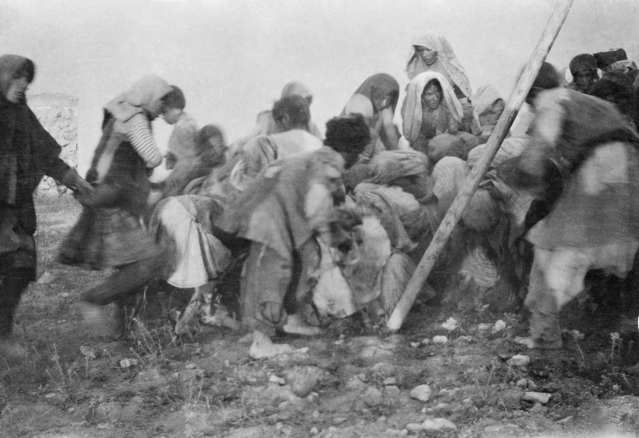
Rare and disturbing photograph in c. of starving and destitute Iranian citizens in the county of Bijar in Iran’s Kurdistan province, fight one another over the entrails of a slaughtered sheep (Source: Public Domain – original photo by the Australian War Memorial Collection). This facet of history is virtually unknown (or ignored) by much of modern day media and academic outlets.
In this book, Mohammad Gholi Majd argues that Persia was the greatest victim of World War One and also the victim of possibly one of the worst genocides of the twentieth century. The author based his research on the great famine in Iran on documents and reports of the US State Department archives as well as from news and information taken from newspapers printed in those years, especially the Ra’d and Iran newspapers in Iran at the time.
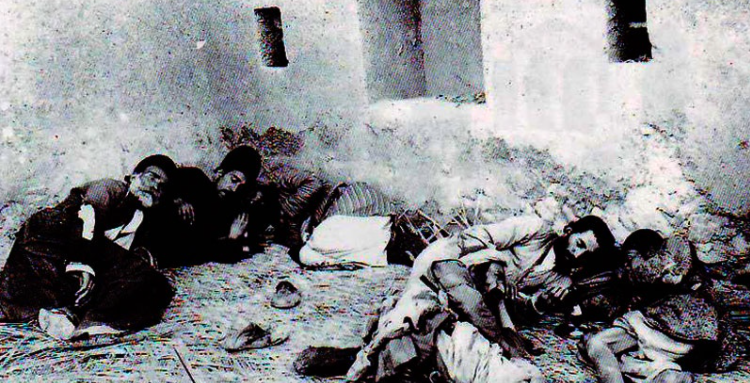
Undated photo of Iranian locals in an unidentified village or town suffering from famine during and right after World War One (Source: Pars Today article “8-10 million Iranians died over Great Famine caused by the British in 1910s”).
Majd quotes the American Charge d’Affaires in Tehran at the time, William Smith Murray, has having claimed that a third of Persia’s population died from a combination of famine and disease. He also used as sources the memoirs of the British officers and commanders who were present in Persia (Iran) during World War I.
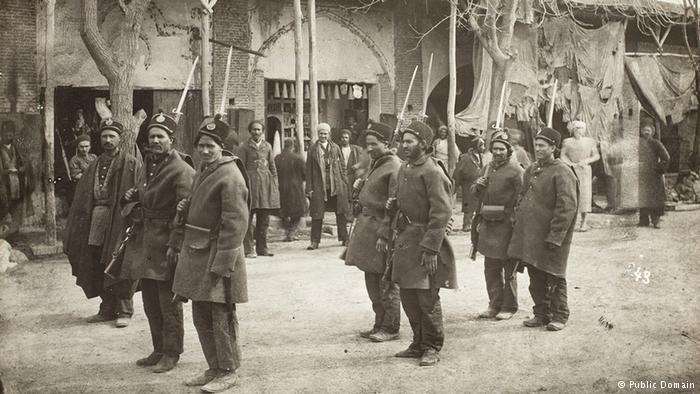
Incapable of defending the realms? The “national army” of Qajar-ruled Iran was in fact a highly ineffective force in the early 20th century, wholly incapable of defending the boundaries of Iran against foreign armies (for more see “The Iranian Army: 1900-1921”). The above photo is that of a small Qajar army detachment in the early 20th century as it prepares to march (Source: قشون نظامی ایران در زمان قاجار and Public Domain). Note the slovenly state of their appearance, such as boots, gear on belts (or lack of), unkempt uniforms (note person in the rear with oversized military coat). Due in large part to the Qajar administration’s mismanagement, cronyism and corruption, the Iranian army by the early 20th century was poorly equipped and trained to defend the country’s borders against Russian, Ottoman and British (or British-Indian) intrusions.
The book reflects on the direct role that the interventionist British and Russian forces played in the famine and subsequent mortality in Iran during the World War I.
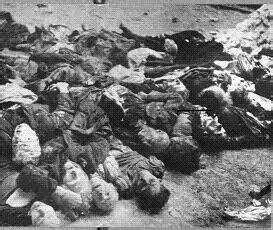
WARNING: Disturbing photo – A photograph (c.1917-1919) of dead Iranians as a result of the holocaust in Iran (Source: Dr. Pat Walsh: Who Remembers the Persians?). Note that the deceased include children and the elderly. While mainstream western scholarship has attempted to deny or gloss over these events as a result of British wartime policies, more attention is being bought to light by scholars such as Mohammad-Gholi Majd as well as western historians such as Pat Walsh.
In large, Majd blames the British who, after the Bolshevik Revolution in 1917, were the controlling power in Persia. Local transportation was taken over by the British for the transport of war materials, isolating farmers from their customers inside Persia.
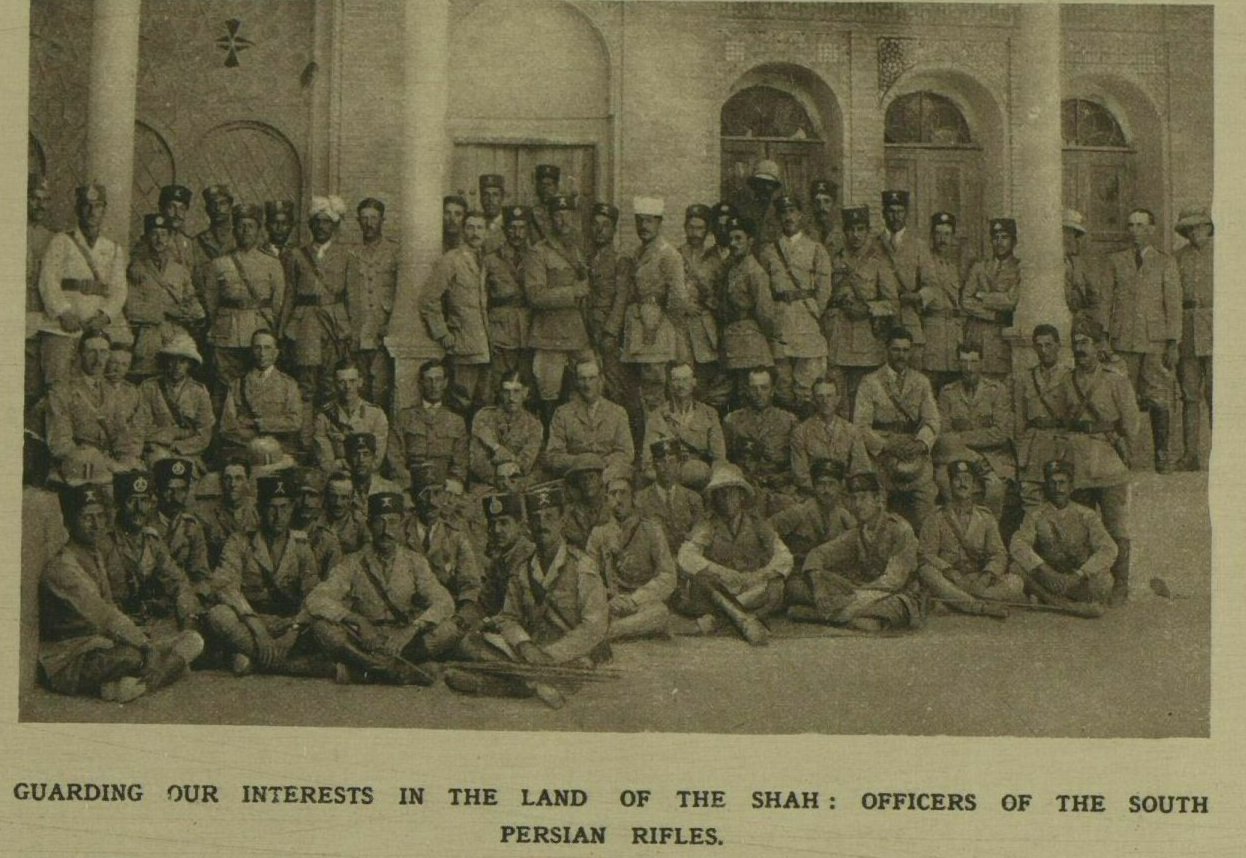
Interesting photograph (1917?) of British and Iranian officers of the South Persia Rifles (S.P.R.) of Shiraz, under the command of Lieut.-Col. W. A. K. Fraser, M.C., of the Central India Horse (Source: The Illustrated First World War). Note the description in the above photograph which clearly outlines the S.P.R.s objectives: “Guarding Our Interests in the Land of the Shah: officers of the South Persian Rifles”.
Majd reports that significant amounts of food were confiscated by the British to supply their own troops both within Persia and in the region.
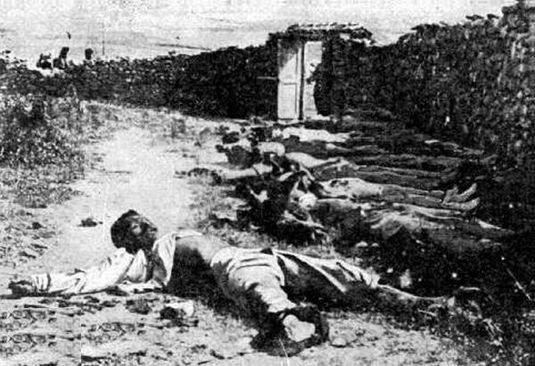
Majd’s conclusion is that, unknown to most, one of THE major genocides of the twentieth century occurred in Persia during and immediately after WW1. In general, one can believe the approximate accuracy of his sources – there was a major famine and millions died – whether it was one third or one half of Persia’s population is purely an academic argument – deaths were literally in the millions and the impact on Persia was enormous. However, “genocide” assumes the deliberate and wilful killing of large numbers of non-combatants. That the British would deliberately undertake this is certainly going to be challenged. Which is understandable – picture in your mind if a third to a half of the US population had died off in WW1 from famine which was made worse by a foreign occupation under the same basis as happened in Persia. What would your reaction be?
What is believable is that this happened: British motives (ignorance of what was happening on the ground or unknown intentions) have yet to be researched . After all, much the same thing happened in India during WW2, were a major famine resulted in millions dying, whilst all the effort of the Indian Govt went into fighting WW2 rather than alleviating the famine. Again, not genocide, just a focus of effort on the war and the ignoring of the fate of millions of civilians who were at best, irrelevant to the war effort.
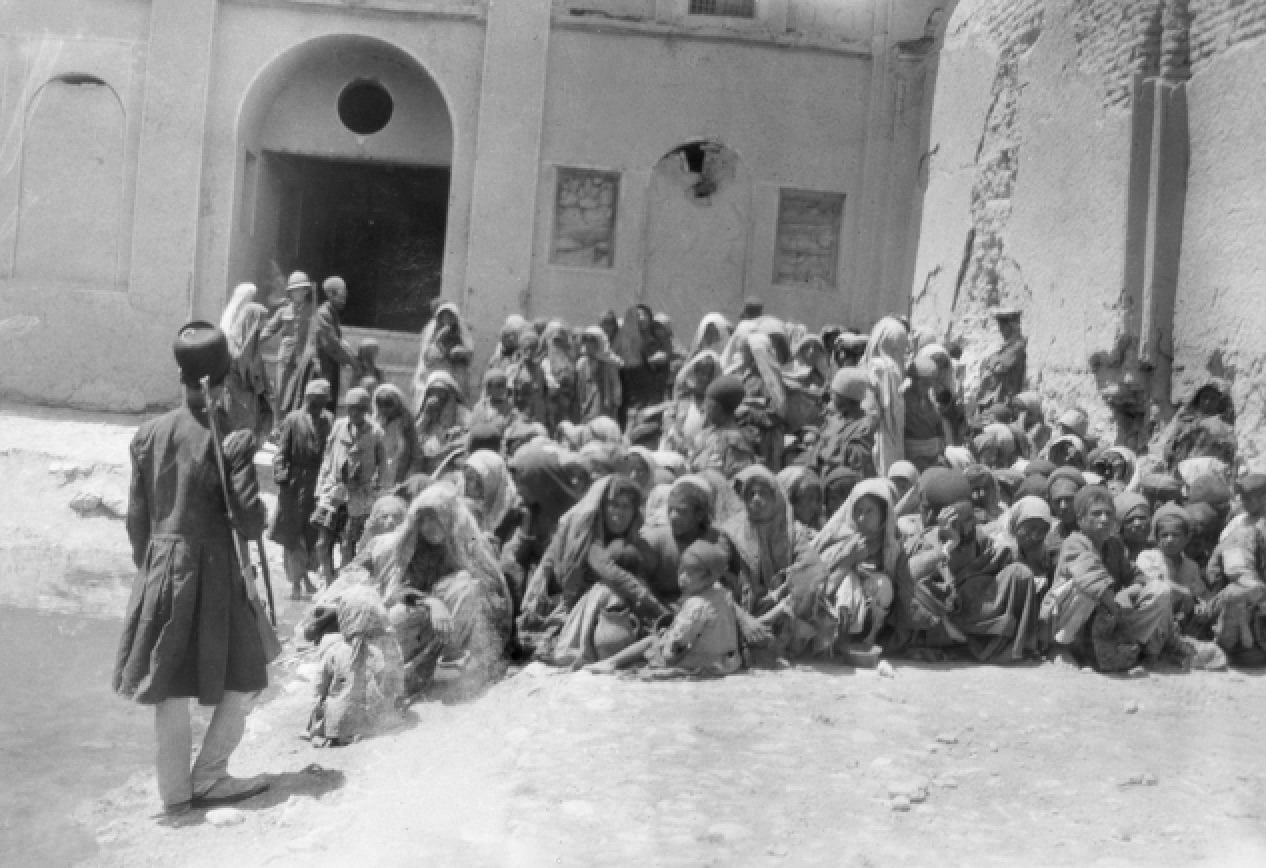
Another photo of Iranian citizens (this time in Bijar) in anticipation of being fed with stew (Source: Public Domain – original photo by the First Australian Wireless Signal Squadron in Bijar). The “stew” was often nothing more that warmed water filled with non-nutritious substances such as straw. Interestingly in the background, near the entrance to the building, is the barely discernible form of a soldier (or officer) attired with what appears to be a British uniform.
Overall, a good study of this little known piece of history but the conclusion that this was a genocidal campaign by the British is sadly erroneous. As with many of the author’s other books, an interesting and historically needed study is marred by an emotional approach and conclusion which really don’t gel with the actual facts. It wasn’t genocide, it was simply that the British focus was on the war and all else, including the fate of Persian peasants, was secondary. However, it’s still a sad state of affairs when the deaths of millions of people is no longer remembered outside of the country where these deaths occurred, if in fact they were ever really known outside of Persia.
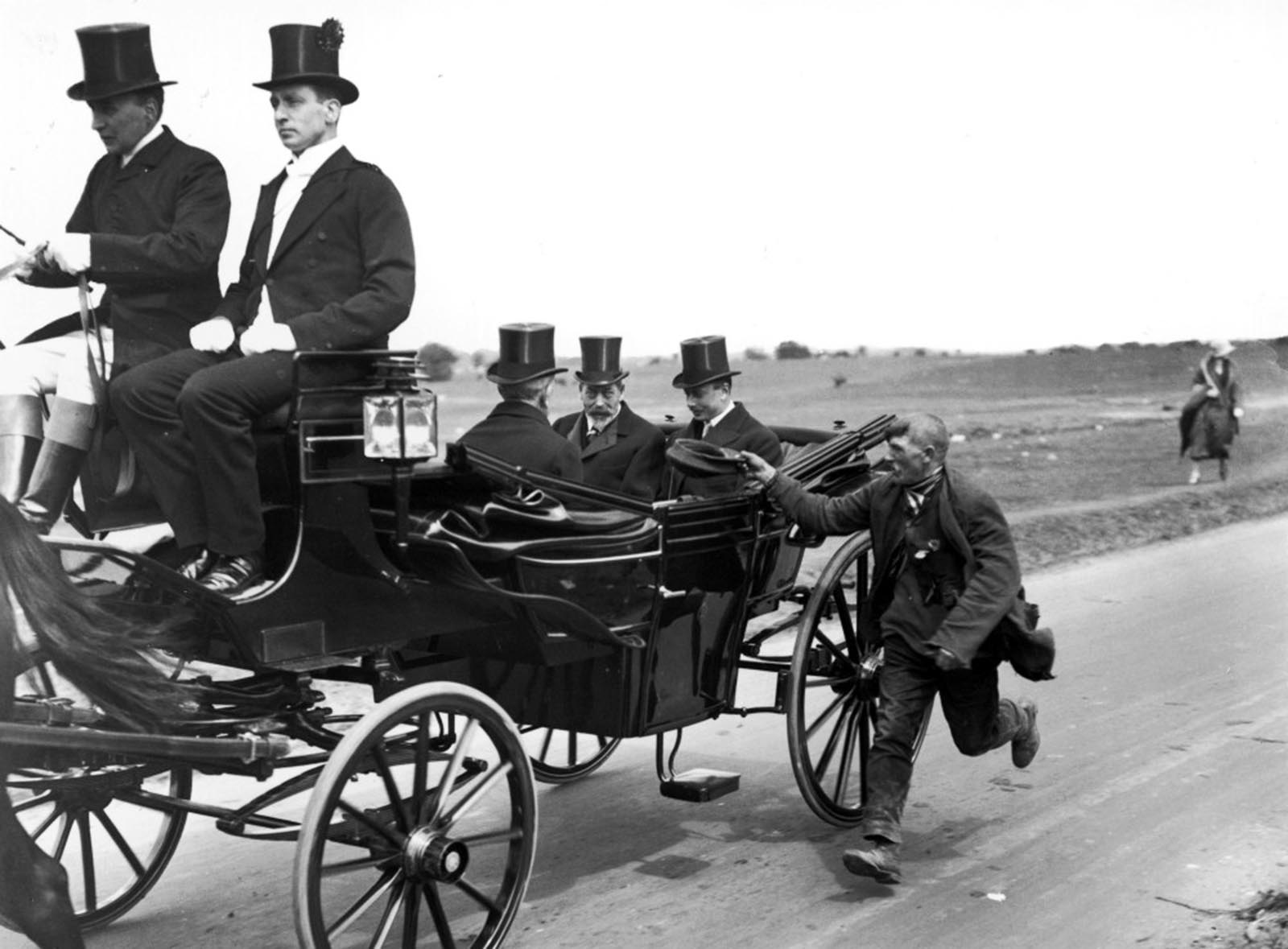
A rare photograph shot in early 1920’s England (shortly after the mass starvation in Iran) showing a British beggar running alongside the royal carriage ferrying King George V and other regal members of the British royalty (Source: Rare Historical Photos). As the destitute running man begs for money, the royal party appear to be embarrassed. This photo serves to illustrate that the ordinary citizenry of countries (both east and west) have little say in the foreign policies of their governments. Casting aside “East versus West” political propaganda (see for example the article in the Persian Heritage journal entitled “The “Clash of Civilizations” Paradigm”), ordinary citizens across the globe often share the same everyday concerns of striving to live their lives in dignity, security, harmony and serenity.
While there are available interesting studies on subjects that are little known outside of Iran, some are harder to read than others, but overall and as a general assessment, they’re marred by a rather biased approach to the topics.
- Iraq in World War I: From Ottoman Rule to British Conquest,
- From Qajar to Pahlavi: Iran, 1919-1930,
- Great Britain and Reza Shah: The Plunder of Iran, 1921-1941
- Persia in World War I and Its Conquest by Great Britain
- Oil and the Killing of the American Consul in Tehran
The article below is a short book review by the Azadmardan Bakhtiari website in Persian:
قحطي بزرگ و نسل کشي در ايران در فاصله سالهای 1917 تا میلادی 1919
نسل کشی در ایران یا هلوکاست واقعیدکتر محمدقلي مجد- استاد تاريخ دانشگاه پرينستون کانادا- کتابي منتشر کرد با نام « قحطي بزرگ و نسل کشي در ايران در فاصله سالهای 1917 تا میلادی 1919» وی بر مبنای مدارک معتبر موجود در مرکز اسناد ملّی ایالات متحده آمریکا ثابت می کند که قحطی بزرگ در ایران در سده بیستم میلادی، در زمان جنگ جهانی اول رخ داده است او در اين کتاب، پرده از رازي بزرگ برداشت و با تکيه بر مدارک به جامانده از سفر او،کارشناسان آمريکايي و اخبار روزنامه هاي وقت، نشان داد که جمعيت ايران در شروع جنگ جهاني اول20 ميليون نفر بوده است. اين جمعيت طبق محاسبه روند افزايش طبيعي جمعيت در آن زمان، مي بايست ظرف 4 سال جنگ جهاني به 21 ميليون مي رسيده در حالي که طبق همه منابع، جمعيت ايران در پايان جنگ 11 ميليون نفر بوده. اين يعني که 10 ميليون ايراني در جنگ جهاني اول از بين رفته اند.کشور ما در جنگ جهانی اول بیطرف بود اما تلفات از همه کشورهای درگیر جنگ بیشتر بود. جنگ، تورم و گراني شدید قیمت اجناس و اقلام را در پی داشت. ظرف 2 سال قيمت گندم 11 برابر شد. قحطي و بيماري در سراسر کشور شایع گشت.
روزنامه « رعد» ( روزنامه سيد ضياءالدين طباطبايي) در شماره 21 فروردين 1297 خبر عجيبي دارد:« مأموران هشت زن را بازداشت کردند که شماري از کودکان را ربوده، کشته و خورده بودند و بهانه آوردند که گرسنگي، آنها را به اين کار وا داشته بود». دهها هزار نيروی نظامی روسي و انگليسي مستقر در ايران به غذا نیاز داشتند. انگليسي ها تمام غله توليدي کشاورزان را به قيمت بالا مي خريدند و روس ها، به روش خودشان، با زور از مردم آذوقه مي گرفتند. در نتیجه به کاهش شدید مواد غذایی در داخل ایران انجامید. عجیب تر اینکه ارتش بریتانیا مانع از واردات مواد غذایی از بین النهرین و هند و حتی از آمریکا به ایران شد. بر اثر چنین فاجعه عظیمی بود که جامعه ایرانی به شدت فروپاشید و استعمار بریتانیا توانست به سادگی حکومت دست نشانده خود را در قالب کودتای 1299 بر ایران تحمیل کند. مجد چنین نتیجه می گیرد: «هیچ تردیدی نیست که انگلیسی ها از قحطی و نسل کشی به عنوان وسیله ای برای سلطه بر ایران استفاده می کردند.» دکتر مجد در کتابش نشان داده که اين نسل کشي فجيع به خاطر خريد کل غله ايران توسط انگليسي ها بوده. با نسل کشی در ایران یک هلوکاست واقعی رخ داد که هنوز با گذشت نود سال انگلیسی ها حاضر به انتشار اسناد آن نیستند. در نتیجه این نسل کشی در فاصله سال های 1917 تا 1919 میلادی بین هشت تا ده میلیون نفر از جمعیت بیست میلیونی ایران یعنی چهل درصد در اثر قحطی یا بیماری های ناشی از سوءتغذیه از بین رفتند. مجد دولت بریتانیا را عامل و مسبب این نسل کشی مهیب می داند و نشان می دهد که استعمار بریتانیا از سیاست نسل کشی و کشتار جمعی به عنوان ابزاری برای سلطه بر ایران بهره برد. در سال 2003 وزارت دفاع انگليس اعلام کرد اسناد نظامي انگليس در رابطه با ايران در سال هاي 1914 تا 1921 هنوز محرمانه اند و تا 50 سال بعد، يعني سال 2053 منتشر نخواهند شد.( مجد ، 13)
شاهدان عینی در منطقه بختیاری اظهار می دارند در آن سالها چنان قحطی شدیدی حاکم بود که بخشی از عشایر بختیاری دست از زندگی کوچندگی کشیده و برای تهیه لقمه نانی روانه مناطق نفتی شدند. بسیاری از روستاها نیز خالی از سکنه شده و به مناطق نفت خیز مهاجرت کردند.تعداد زیادی از مردن نیز به دلیل سوء تغذیه و بیماری جان خود را از دست
================================================================================
References and Further Reading
1. Majd, Mohammad Gholi. The Great Famine & Genocide in Iran: 1917-1919. Lanham : University Press of America, 2013. p.71: https://books.google.com/books?id=5WgSAAAAQBAJ&pg=PA71&lpg.
2. Sniegoski, Stephen J. Iran as a Twentieth Century Victim: 1900 Through the Aftermath of World War II. mycatbirdseat.com. [Online] 11 10, 2013. [Cited: 10 12, 2015.] http://mycatbirdseat.com/2013/11/iran-twentieth-century-victim-1900-aftermath-world-war-ii/.
3. Donohoe, Major M. H. With The Persian Expedition. London : Edward Arnold, 1919. p. 76.
4. Nelson, Michael and Briggs, Asa. Queen Victoria and the Discovery of the Riviera. London : Tauris Parke Paperbacks, 2007. p. 97: https://books.google.com/books?id=6ISE-ZEBfy4C&pg=PA97&lpg.
5. Bower, Graham. Sir Graham Bower’s Secret History of the Jameson Raid and the South African Crisis, 1895-1902. Cape Town : Van Riebeeck Society, 2002. p. xii: https://books.google.fr/books?id=VFYFZKRBXz0C&pg=PR23&lpg.
6. Ibid. p. xvii.
7. Cobain, Ian, Bowcott, Owen and Norton-Taylor, Richard. Britain destroyed records of colonial crimes . The Guardian. [Online] 03 17, 2012. [Cited: 10 10, 2015.] http://www.theguardian.com/uk/2012/apr/18/britain-destroyed-records-colonial-crimes.
8. Walton, Calder. Empire of Secrets: British Intelligence, the Cold War, and the Twilight of Empire. New York : The Overlook Press, 2013. p. 15: https://books.google.fr/books?id=f2cjCQAAQBAJ&pg=PT15&lpg.
9. Warfield, Brian. History Corner: The Great Irish Famine. wolfetonesofficialsite.com. [Online] [Cited: 10 12, 2015.] http://www.wolfetonesofficialsite.com/famine.htm.
10. Britain’s Cover Up. irishholocaust.org. [Online] [Cited: 10 12, 2015.] http://www.irishholocaust.org/britain’scoverup.
11. Coogan, Tim Pat. The Famine Plot: England’s Role in Ireland’s Greatest Tragedy. New York : Palgrave Macmillan, 2012.
12. O’Dowd, Niall. Proving the Irish Famine was genocide by the British. IrishCentral. [Online] 08 06, 2015. [Cited: 10 12, 2015.] http://www.irishcentral.com/news/proving-the-irish-famine-was-genocide-by-the-british-tim-pat-coogan-moves-famine-history-unto-a-new-plane-181984471-238161151.html.
13. Bharier, Julien. A Note on the Population of Iran, 1900-1966 . Population Studies. 1968, Vol. 22, 2.
14. Amani, Mehdi. La population de l’Iran. Population (French Edition). 1972, Vol. 27, 3: http://www.jstor.org/stable/1529398.
15. Floor, Willem. Reviewed Work: The Great Famine and Genocide in Persia, 1917-1919 by Mohammad Gholi Majd . Iranian Studies. Iran Facing the New Century, 2005, Vol. 38, 1.
16. Fecitt, Harry. Other Theatres of War. westernfrontassociation.com. [Online] 09 29, 2013. [Cited: 10 12, 2015.] http://www.westernfrontassociation.com/the-great-war/great-war-on-land/other-war-theatres/3305-dunsterforce-part-1.html.



